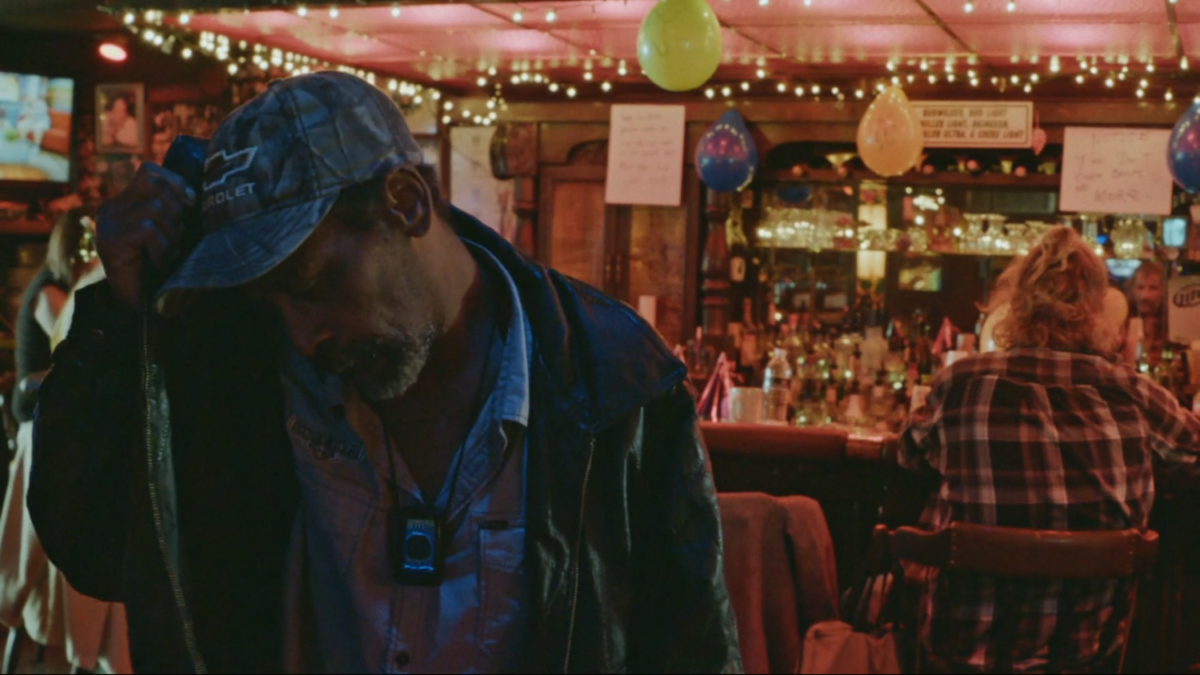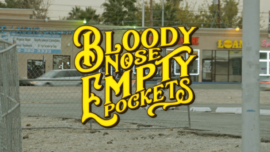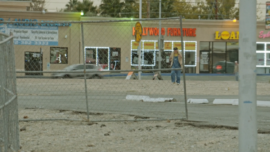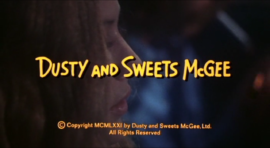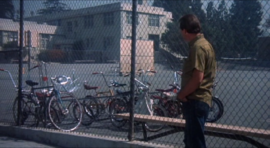To hell with the truth! As the history of the world proves, the truth has no bearing on anything. It’s irrelevant and immaterial, as the lawyers say. The lie of a pipe dream is what gives life to the whole misbegotten lot of us, drunk or sober. And that’s enough philosophic wisdom to give you for one drink of rotgut.
Larry Slade in The Iceman Cometh (Eugene O’Neill, 1939)
Plenty has been written on truth in cinema, and perhaps even more on the question of realism. But as Larry Slade, the one-time Syndicalist-Anarchist from The Iceman Cometh rightfully suggests: to hell with the truth. The most exciting things happen in the imaginary, or in the blurring of fact and fiction. Among the films that are well-aware of their own ambiguous position on the spectrum of truth, and that have no desire to be trusted as objectively true, but that embrace their own presence in voice, framing and imagination, are those brought together under the name of docufiction. Jean Rouch, who has often been called the father of the docufiction, thought that hiding cameras in the name of truth is ‘disgusting’ and ‘dishonest’. Rather than obfuscating the tool that is supposed to mediate the truth, his concept of ciné verité accepts the presence of a camera and a cameraman as part of that truth that is eventually portrayed. But the idea of docufiction goes further than this preliminary acceptance, actively seeking to build a truth on screen that does not know its equal outside of the film—which sounds just like fiction. At the same time, projects of docufiction often lack either a plot, a script, professional actors, a built set, or various combinations of the above-mentioned, which takes away the overall control and premeditated character of fiction films.
So to continue with Larry, the lie of a pipe dream gives life, drunk or sober. But what to make of the proverbial in vino veritas when added to an already complicated chalice of truth, lies and pipe dreams? What to do with the depiction of alcoholism and general drunkenness in docufiction?
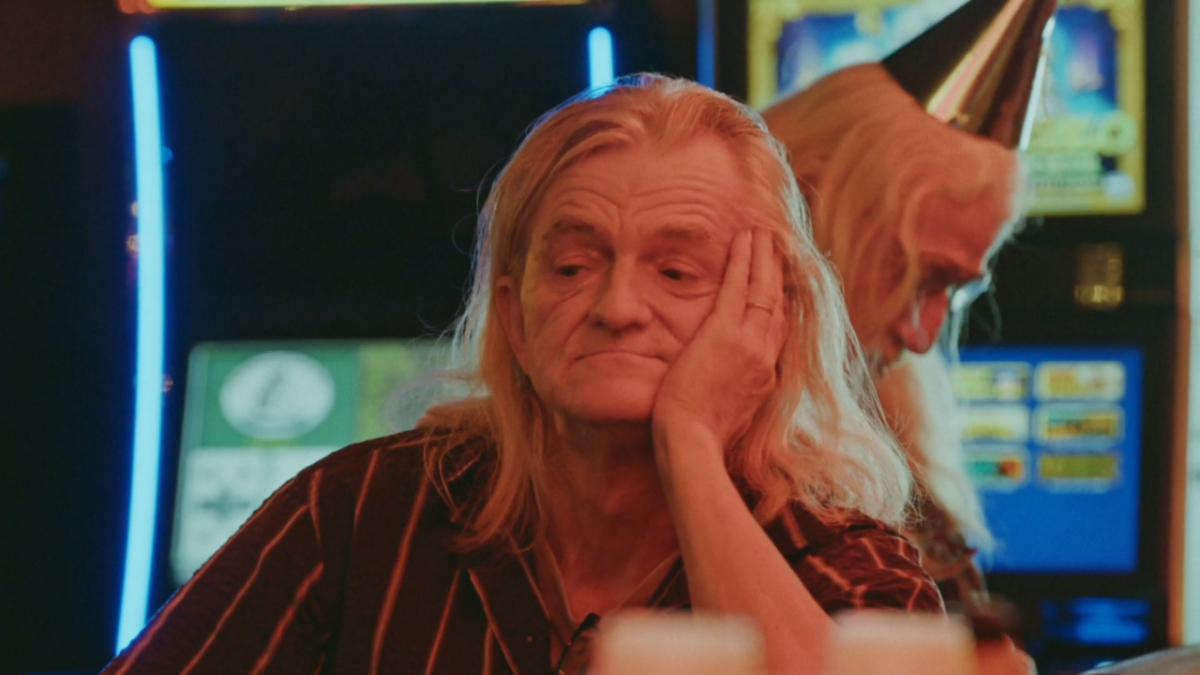
How many shots does it take?
Anyone who ever had a drink, danced in a nightclub, sat in a bar or watched Bloody Nose, Empty Pockets, the latest feature by Bill IV Ross and Turner Ross, knows that alcohol is capable of changing the demeanor, mood and volume of just about anyone. Filmed in 2016, but only released this year, Bloody Nose tells the tale of a Las Vegas bar called ‘The Roaring 20s’, celebrating and mourning its last night in business, one day after Donald Trump was elected single-term president of the United States. The regular customers pay their last respects to the bar they probably called home, sharing laughter and tears, dancing and drinking until dawn, lighting fireworks in the parking lot.
Although it comes across as pure and raw documentation—zooming in on the WordArt poster made especially to announce the closing festivities—Bloody Nose, Empty Pockets was not shot in Las Vegas, the bar does not close down after this night and the majority of the guests are not regular customers; making Bloody Nose, which premiered in the documentary section at Sundance, an exemplary case of the hybrid docufiction genre.
Both armed with their camera, the Ross brothers set out to build a truth-in-fiction. In their attempt to create a certain memoir of a staged familiarity, of people reacting to a space, of a sentiment in time, they chose a ‘four wall’ kind of bar, enclosing a fictional world, creating a safe space for a dynamic story or an experience to evolve. Over a hundred bars were ‘auditioned’ to play the role of the habitual haunt, and only one would make the cut. Likewise, numerous people were auditioned and interviewed, to create an amalgam of voices, ages and dancing skills. There’s a single experienced actor, Michael Martin, added to a cast of not-(yet)-professional-actors. Bill Ross met Martin in 2012 when he was in Vegas performing the Eugene O’Neill piece Long Day’s Journey Into Night, a story about addiction and family issues. A few years later they set him center stage amidst a group of heavy-drinkers (his equals) in a bar, which sounds a lot like the plot summary of that other O’Neill play, The Iceman Cometh, in which drunks and ‘foolosophers’ go about their usual business. Early on in the film, Michael portrays his peaceful resignation into the welcoming embrace of alcohol:
I’m proud of myself for not having become an alcoholic until after I was already a failure. I ruined my life sober. And then I came to you.
How many shots did it take to get this phrase right? Probably just a single one. The directors made it clear in the many interviews they gave, that there was no script to work with and that no dialogue was imposed on the actors. It only adds to the joy of hearing a grown-up woman shout “I wanna be immature. That was my dream in life. The American Dream. Immature. That’s me,” later in the film, knowing she owns one hundred percent of what she’s saying.
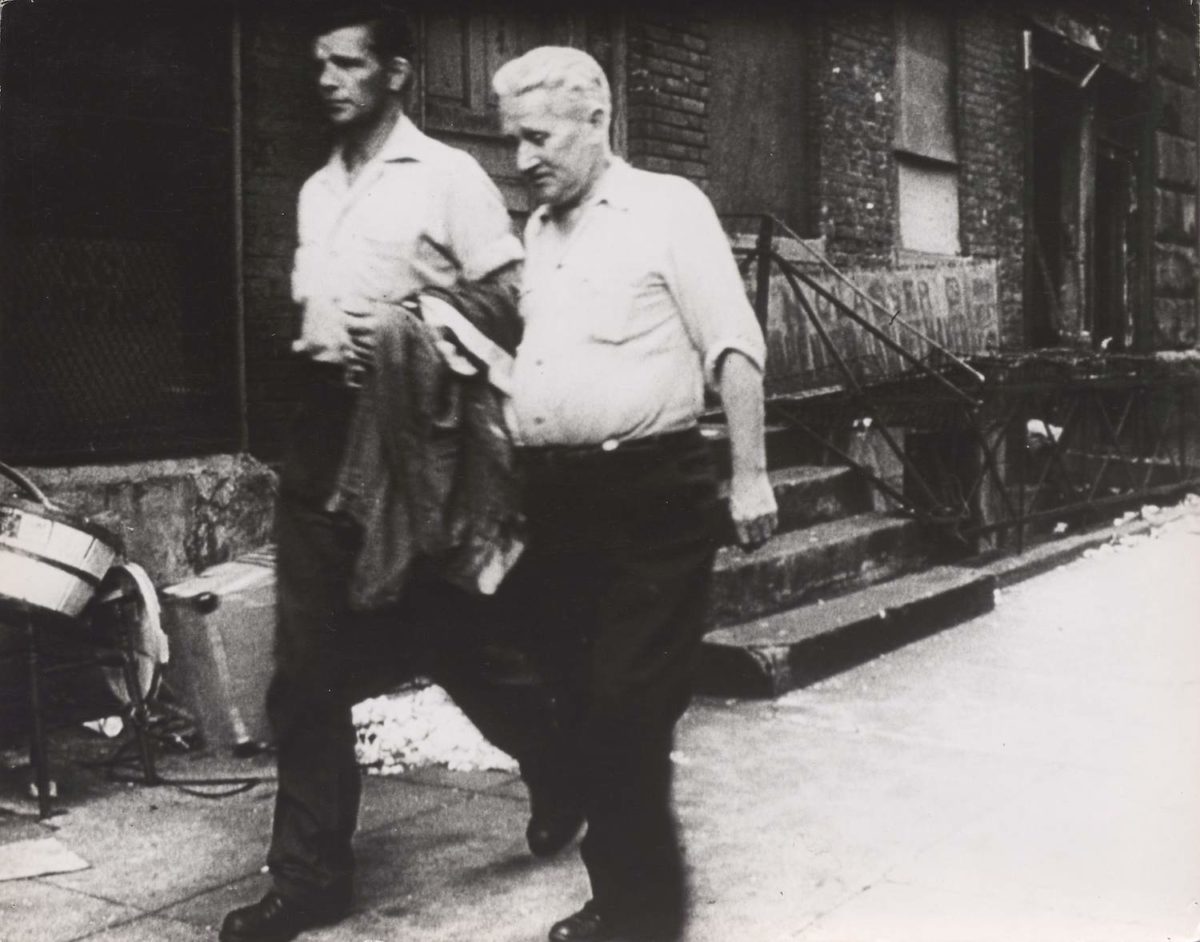
“Don’t hog, man”: collaboration in The Exiles and On the Bowery
Just as O’Neill’s Long Day narrative—as the title suggests—covers a single day, so does Bloody Nose portray a single night, which was mostly shot in a single take. For the largest part of the film, the brothers used 18 hours of consecutive footage shot with handheld digital cameras. Kent MacKenzie, one of their preceders working on the same theme, had to work with leftover 35mm film stock for his The Exiles (1961), making it a lot harder to secure continuity, or to grasp unforeseen, unimagined or unscripted excitements. Shooting The Exiles took over three full months (in which cameramen were drafted by the army and actors had to be bailed out repeatedly). The same goes for Lionel Rogosin’s On the Bowery from 1956, which directly influenced both MacKenzie and the Rosses. The two films depict a story similar to Bloody Nose, following a group of people on a night out, although the setting is less fixed, with the crews occasionally following their actors on the road, something the Ross brothers cut out completely (although they did consider it for their four-hour version). In On the Bowery, just as in Bloody Nose and The Exiles, the actors are acquainted neighbors, friends or people picked up from the streets; Ray Salyer, in the leading role, remembered the screenwriters coming up to him:
When Mr. Bagley and Mr. Sufrin asked me if I wanted to act in a picture, I thought: “What are these jokers up to?” but I figured I could handle them, so I went along.The Village Voice, March 27, 1957, page 12
On the Bowery won the first prize at the Venice Film Festival in the documentary section, where The Exiles premiered a couple of years later. Carl Lerner, the editor of the film, who edited Sidney’s Lumet Twelve Angry Men in the same year, recalled that he had great freedom in editing Rogosin’s early features, because they were made up of “flexible story situations, with much random material.”Lerner, Carl. ‘Odyssey from Hollywood to New York’. Film Comment 2, no. 4 (1965): 3. The same is true for Bloody Nose where the simple plot line (party like there’s no tomorrow?) was communicated in advance and once the cameras started rolling, the actors went about their normal business. Their conversations with the crew and frequent looking into the camera were cut out for the largest part, avoiding an alienating effect and allowing the audience to dive into a fiction. Yet, that it was all staged is never denied, the cameras sporadically visible in the mirrors behind the bar. It all adds up to a curious and continuous shifting of fact and fiction. “We are there,” says Bill Ross in an interview with Slant magazine, “if we weren’t there, there wouldn’t be a film.” They’re not there in voice-over commentaries, in extensive intertitles or in script writing, they’re just there to start the story, be part of it and create the remembrance of it.
Lionel Rogosin felt no different. He never tried to write out a documentary, or to capture an entire community. In an attempt to zoom in on the daily lives of a couple of Bowery bums scouring the streets for money and drinks (or money for drinks), which forms a starting point for numerous films, On the Bowery diverges strongly from This is the Bowery (Gunther von Fritsch, 1941), a ten-year earlier portrait of skid row, in which a poetic voice-over leads the image, or How do you like the Bowery? from 1960, which involves a microphone held under the noses of drunk old men. In the former the people depicted have no voice whatsoever, in the latter they repeat the same lines they’ll eternally feed to anyone who wants to hear it (or not). Rogosin mediates between these two, discerning the visceral. Like the Rosses, he asked real people to act in his film. He follows the middle-aged Ray Salyer, who just finished a job and is looking for another throughout the film. Sleeping it off on the streets after some drinks, one of his new friends steals his money and belongings. Salyer’s future looks a little less bright, the Bowery street lights a bit brighter. Rogosin staged certain scenes, but no style or voice were imposed. The actors are not pulled out of their comfort zone—same goes for Bloody Nose—rather they’re made consciously aware of their own existence within this space because of the camera that follows them around. Their handling and acting is hesitant, uncertain and open; there could hardly be more true and telling depictions of their characters.
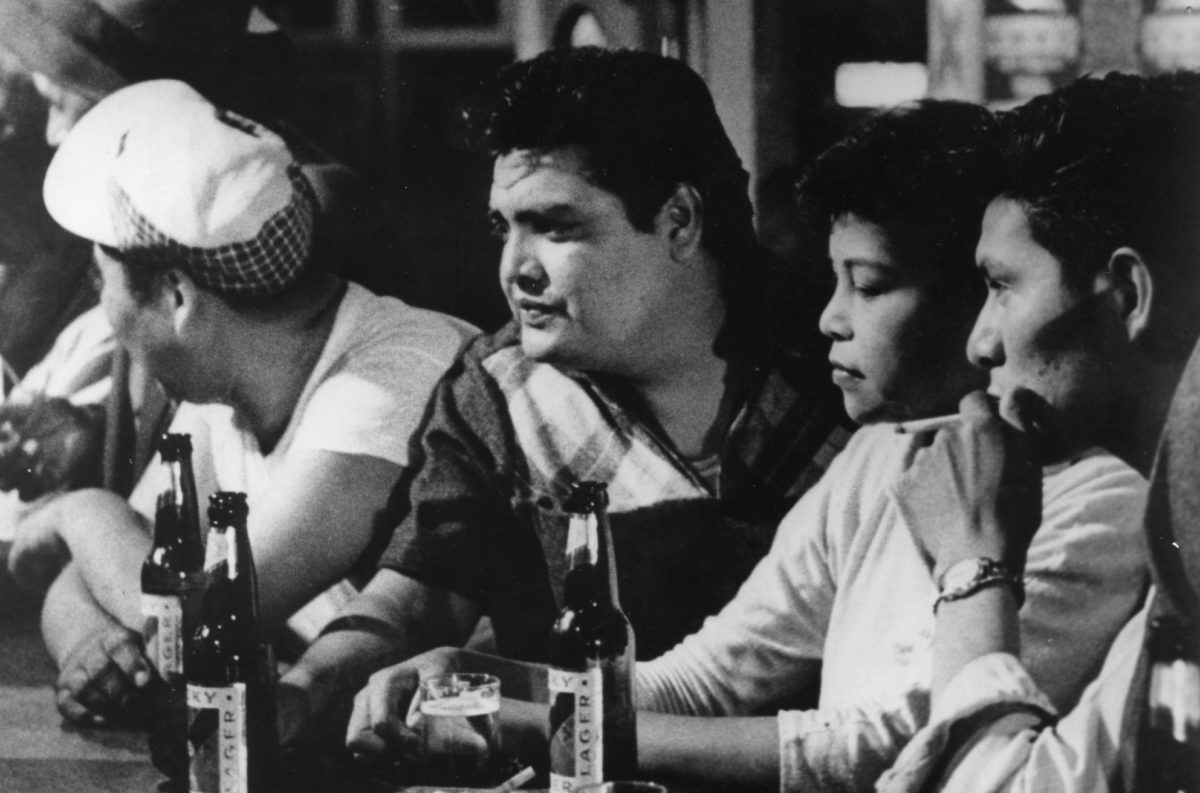
Among many other films from the sixties and seventies that influenced Bloody Nose, such as the works of John Cassavetes and Shirley Clarke, Kent MacKenzie’s The Exiles stands out because it comes closest in theme and approach, capturing drunkenness in docufiction. It appears as if O’Neill, Rogosin, MacKenzie, Ross and Ross were all aware of the same natural (or productional) limit that goes with capturing intoxication, which is to keep the timeframe short and strict because just as in On the Bowery and Bloody Nose, in The Exiles we once again witness a single night out, from dusk ‘til dawn.
MacKenzie follows a group of young Native AmericansThere’s an early nod to the Native American community (and perhaps to MacKenzie’s film) in Bloody Nose. Ten minutes into the film, the Rosses cut to Alex Trebek’s Jeopardy! quiz playing on the television, where the quizmaster asks the name of the largest indigenous tribe—Navajo, for those who wonder. Apart from ‘Native Americans’ being the last category picked, the more painful fact is that none of the contestants knew the answer. who traded the Southwest for Los Angeles, mostly focusing on two guys called Homer and Tommy and a woman named Yvonne. The Exiles opens with a montage of portraits of Native Americans, shot by anthropologist Edward S. Curtis, set to Amerindian music by Mescalero Apaches, Eddie Sunrise Gallerito, Frankie Red Elk and Chris Surefoot, and accompanied by a bookish voice-over. This entire historical introduction was apparently only added after a first few screenings for audiences who thought the film was too abstract. MacKenzie then juxtaposes this sequence with a scene of two young Native Americans, reading superhero comics, listening to The Revels, living in L.A. If this was originally intended to be the opening scene of the film, then the in-between-state of an identity, the ongoing blur of a past and a present, would have been equally clear.
In contrast to Rogosin and the Rosses, MacKenzie doesn’t shy away from using voice-over throughout the film to fill this much-feared in-between-state. He starts off with an academic talk in those opening minutes but quickly exchanges it for commentaries by the actors themselves: memories of the reservation, murmurings about a future and drunk recollections that double the in-between state of mind. Does one say more truthful things when drunk? Does one have more spectacular memories? Almost all of the sound was recorded afterwards in a sort of stream-of-consciousness, at times verging on poetry. MacKenzie lets Tommy speak out his melodic thoughts—which are complete riddles most of the time—and leaves them unaltered:
When I booze, I’m not gonna sip on the drink. I did drink and get high. That’s the reason drinks are for.
The young friends come together at the end of the film, playing music on a hill that looks out over the city, trading in the rock-’n-roll from the jukeboxes for real life drums, clinking beer bottles, singing in unison, and sporadically starting a fight; the way it goes in all of these films (and all of real life). In the end, the men look out for each other, mostly making sure they don’t finish each other’s drinks: “Pass the jug over there, will you. Don’t hog, man.”
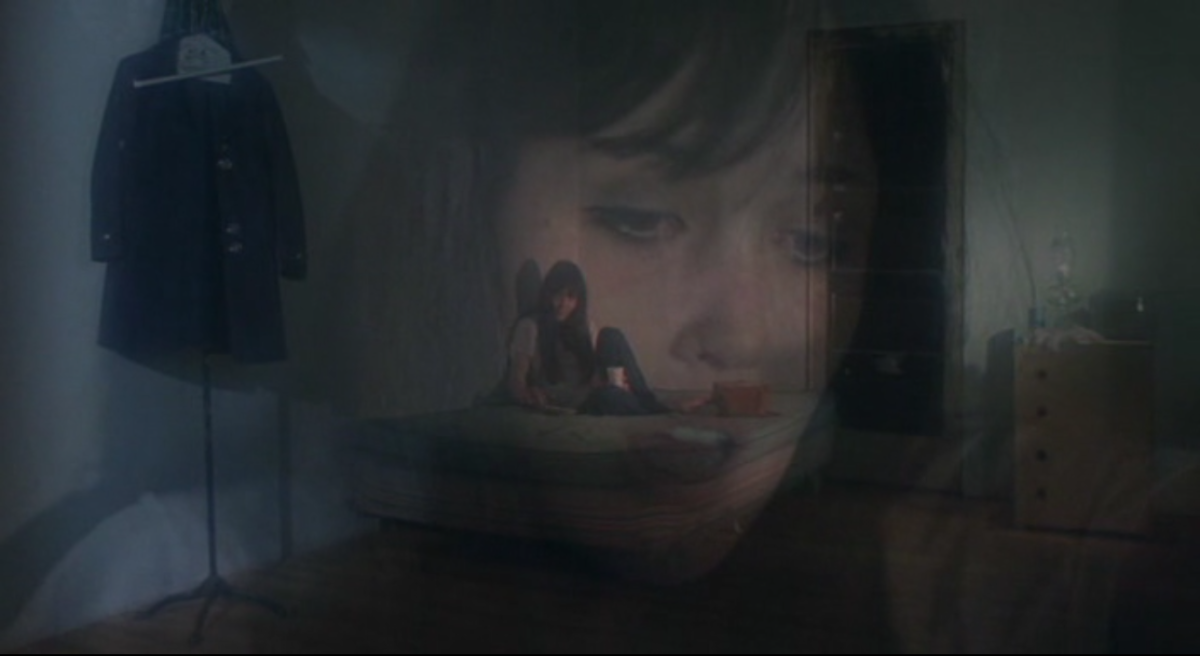
“I mean everything I say, or something not unlike it”: to each his own truth
Bloody Nose opens with the first sentence of the Declaration of Independence: “We hold these truths to be self-evident.” Free, independent and equal are all actors, crew and audiences. It doesn’t matter how it is made, there are inherent truths in this film, in every film; it is up to each and everyone to decide for themselves what those are.
Following this quote are opening titles in a creamy yellow font and the introduction of a first character, framed by a metal fence; a clear homage to one of the Rosses’ major influences, a film that starts in almost the exact same way: cult classic Dusty and Sweets McGee (Floyd Mutrux, 1971), which already served as inspiration for their earlier film Western (2015). “We will be stealing everything we can from it in the future,” and so they did.Weston, Hillary. ‘Directors Bill and Turner Ross on the 5 Films That Inspired Their New Documentary ‘Western’’, BlackBook, September 24, 2015. https://blackbookmag.com/arts-culture/film/sundance-doc-prize-winners-bill-and-turner-ross/ Dusty and Sweets McGee too, before its yellowy title and credits, opens with a statement on truth: “Pam and Larry, Tip, Kit Ryder, Beverly, Mitch, Armen and Bob Graham are real people. They are not actors.” They are real people addicted to real heroin, yet they do not compose the entire cast. The film is a tricky game of what is real and what is not, it is a restaging or a retelling of facts and stories that happened to people in and outside of the film, which Mutrux had gathered through interviews (out of which he only later decided to make a film).
While some of the characters play themselves and bring their own stories to the table, others are portrayed by hired actors. In for another weekend of intoxicated fuzziness, the camera follows those “pissed at life”, a plain “twentieth century faggot”, a teenage couple of drug addicts, street hustlers and an ex-convict. How scripted is Dusty and Sweets? When you hear a young woman say her life exists out of “chickens, tv, crossword puzzles and shitty hotels,” you hope she’s making it up, but as her boyfriend points out at the end of the movie, it all just gets “fuckeder and fuckeder.” Dusty and Sweets (who are actually called Beverly and Mitch) are announced with birth date, address and addiction; 22 and 20 years old when the film was shot in 1969. The end credits say they “didn’t make it”; in fact Mitch passed away a year after the film was released, after already another character (Nancy Wheeler) died of an overdose just weeks after the film was finished.Because there is little factual information, judgements are in any case difficult to make. The blurry boundaries of the docufiction genre caused great stress to the leading actor, who was repetitively referred to as a real-life drug-addict in reviews, even though he specifically asked for the opening credits to state he is not. Very subtly, Billy Gray is credited “as city life superdealer born to lose,” a sentence in which “as” is an unfortunately small word that didn’t prevent the critics from labeling him a drug user altogether, which he fiercely fought.
Similar to The Exiles, there’s a voice-over throughout the film, contrasted once in a while by interview snippets, answers directed intermittently to someone behind or someone next to the camera, reinforcing the documentary feel. There are pairs of eyes looking straight into the camera, and pairs avoidant of it. Trained and less trained postures. There’s muttered speech, drowsy eyes. A singular gorgeous slow dissolve, a heist, and a tragic overdose convey the spectacular fiction of dreams, fears, and wannabe truths pushing the film back onto uncertain grounds. Is all this still real? The interviews are straight from the heart, Kit promises that he means everything he says—or something not unlike it, which is just about the overall sense you get from the film. It might not all be true, but there are inherent truths in there to be picked up and you better believe it.
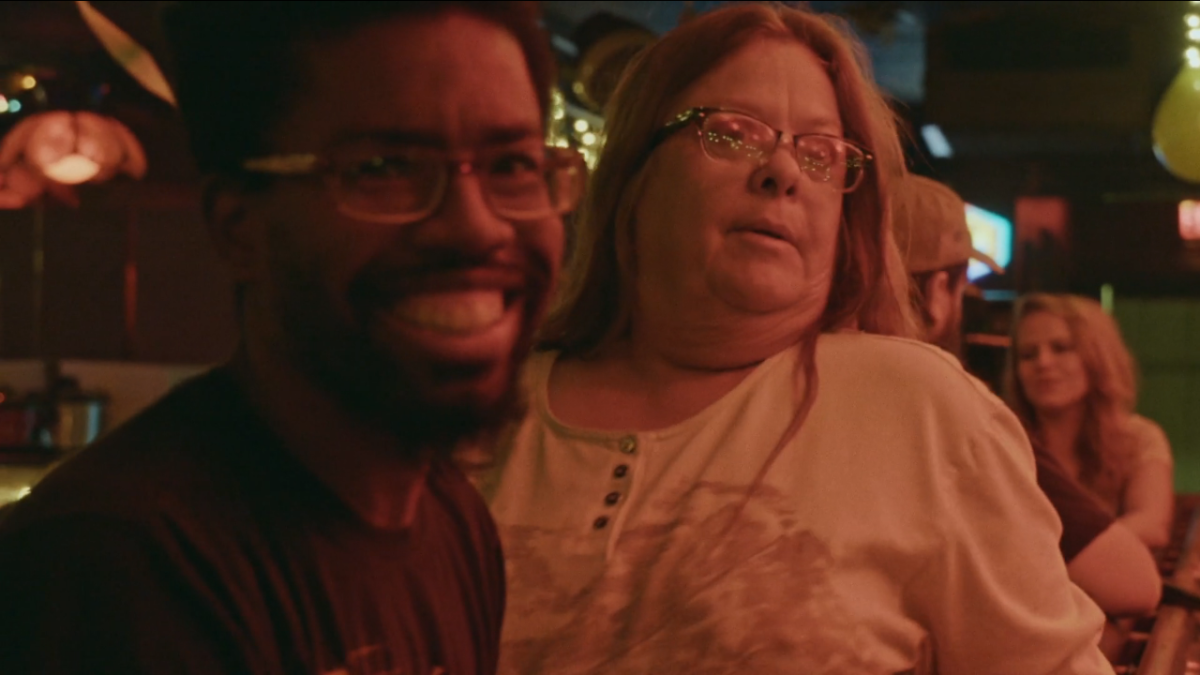
“A heap see, but a few know”: archetypes, actors and actual people
The marvel of watching the Bloody Nose, Empty Pockets cast gradually get drunk—which is really thanks to the technical possibility of capturing everything ‘at once’ in contrast to the films made a few decades ago—is seeing everyone sliding into a more caricatural version of themselves, knowing there’s no way of turning back or starting over. When the directors talk about the characters in the film, they often repeat they were looking to create a cast of archetypes that are on the one hand still inhabited by real individuals living their own life, whilst simultaneously communicating a likeness to a larger audience, offering everyone their own reflection. Perhaps the actors enter the movies as their startled selfs, not exactly sure what to expect from this experiment—or like one actor, Kamari, explained: it is an interesting way to spend the day and there’s some free food and drinks and a little bit of money, “so yeah.” But as the 18 hours continue to count down, the individual stories become blurry and when you cross-eye the room there are only silhouettes to be discerned, archetypes taking over. The question is how to shoot a movie with mere negative outlines of moving bodies rather than fully embodied beings as your cast.
Once the alcohol settles in, a whole spectrum of drunks appears on screen. There’s the loud, the sad, the horny and corny ones, the political, the mad and the angry ones and there’s the one who is trying to seduce the bartender with the ten-year old son: “I’m a pretty good stepdad usually.” Between these people in the Roaring 20s bar, some disconnected yet warm understanding grows. Disconnected because the alcohol functions as a filter, keeping everyone from actually reaching one another. They rather listen to themselves talking to others. How promptly warming is the moment where the ex-military man positions himself before the immobile camera to show off his best dance moves. Ironically, he becomes an actor in a film that never asked for actors in the first place. Warm too are the numerous heartfelt gestures, tears welling up the way they do every night. One minute Pam thumps her fist on her heart in a veritable emotional moment, the next she’s showing her 60-year old titties that do not look their age, looking for a compliment from a young man. He looks into the camera, afraid to, and turns away again.
At other times, poetry rises to the surface—“Senses. That’s something I appreciate. When you wake up in the morning and you go outside, the smell of the dew on the grass, …”—or hard boiled facts are put on the table, no arguing with a man saying “You was bad at being alive, and your generation was bad at that too.” The ex-military man tries and tries to tell the crowd that “a heap see, but a few know,” but, unable to un-slur his words, the message is lost in a few giggles over mispronounced words. The more the hours and booze flow through them, the harder it becomes to hold the inebriates accountable for their behavior. What has been drunk, has been drunk. Bloody Nose is filled with little dei ex machina that take care of those whose time has come to go home. One man is called away to work—highly unbelievable since he can’t seem to find out how his legs work—and Pam too seems to be leaving not entirely voluntarily, missing out on the firework finale. Completely pie-eyed, yelling random vulgarities, she nevertheless did not forget she’s acting in a film, shouting at everyone to enjoy their last evening, as they were told it was. If, on the other hand, she was not acting, the fiction became a truth right then and there.
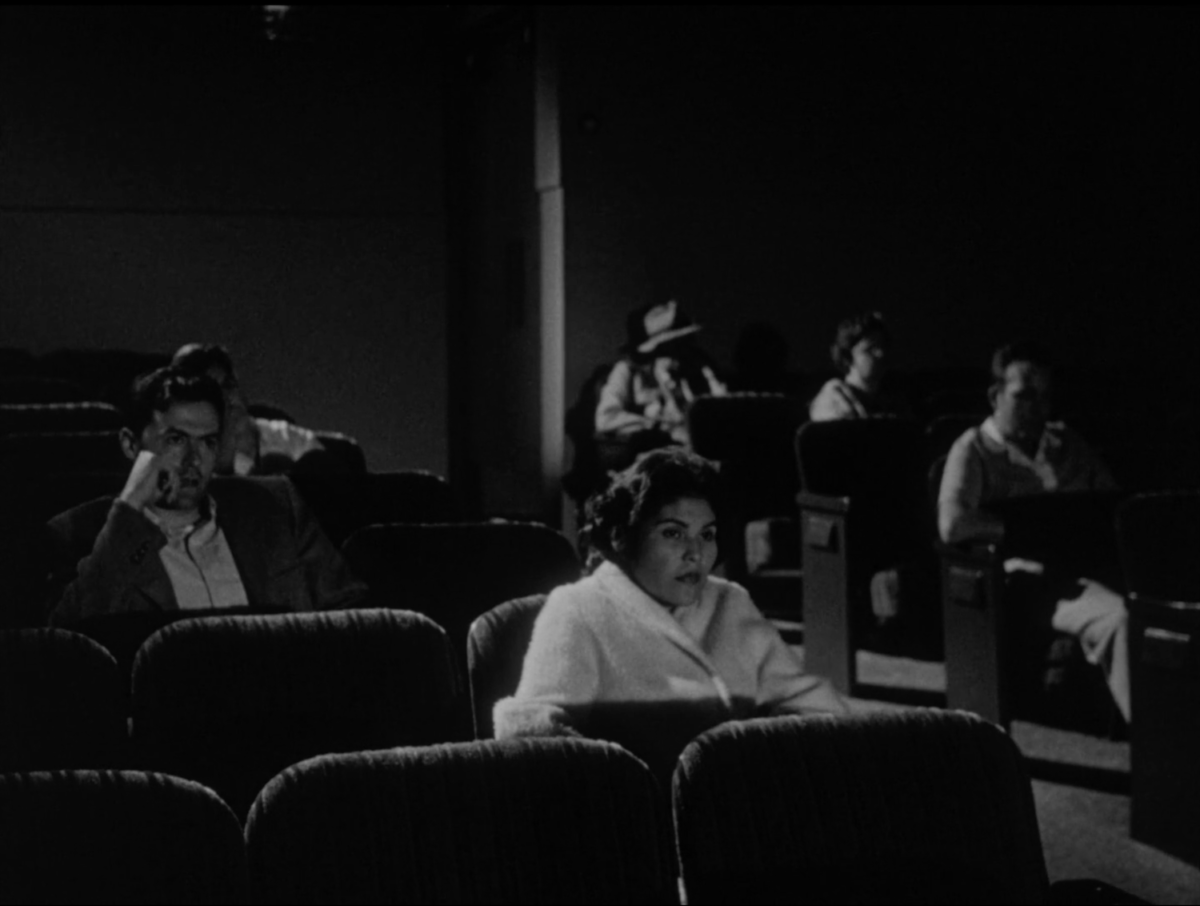
The good, the bad and the ugly drunks: a question of ethics
To this acting under the influence, even when you are playing more or less yourself, the question of ethics follows automatically, as so often with any form of documentary—especially when it involves humanity in its most vulnerable state. In his review of the 2010 Dusty and Sweets DVD release, Thom Andersen summarized the tension that runs through most of these films pretty well:
Somehow the “real people,” as the introductory titles designate them, seem to end up in a fiction, and the actors in a documentary.Andersen, Thom. ‘Happy Daze’. Film Comment 46, no. 2 (2010): 20. It is the same Thom Andersen that made the 2003 Los Angeles Plays Itself video-essay in which he reintroduced The Exiles to a new audience after it had long been forgotten.
This hybrid form of documenting realities frees the directors from the ethical framework and self-censorship hardcore documentary filmmakers have to deal with. There’s a clear space left open for creation, for interaction, for dialogue, where the camera serves not merely as a window to the world but—to say it with a caramel phrase—becomes a canvas for cooperation. The Ross brothers were not mere outsiders, they knew some of the actors beforehand and got to know the others soon enough. They joined in on the fun once in a while, were always addressable during the shooting, and made sure everyone was comfortable. Kent MacKenzie and Lionel Rogosin were equally observant ‘insiders’ to the group of people they made their films with, not about. When Yvonne sits in the cinema for a double-bill, you can catch MacKenzie sitting right behind her. MacKenzie also paid extras with tokens for beer in the bar where they were filming.
Floyd Mutrux recreated past conversations or actions; the Rosses let lengthy heartfelt dialogues run on during the shoot, afterwards editing them to consumable sizes, but also making a four-hour cut keeping them intact; The Exiles did have a script and there were rehearsals, but both text and situations were written together with the actors, and the dialogue was improvised and later approved by them. Docufiction allows for a nonjudgmental and playful approach which is very welcome when pretty much your entire cast is under the influence. It maintains an openness for stories to evolve before the cameras, there is little pressure on what has to be said, there’s no moral twist, no summarizing plot to warn viewers like cigarette packs do. Dusty and Sweets McGee was withdrawn from theaters after just one week, because it didn’t state clearly enough that drugs are bad, yet at the same time it is listed elsewhere as an anti-drug film. It is neither, it doesn’t pronounce a verdict.
All of these filmmakers found a way to portray states of delirium neither romantically nor abhorrently. Handheld cameras; interviewing (real) people before, during or after the shoot; real locations alternated with the occasional set; a rehearsed movement or a slight push in an otherwise plotless moving picture: all these elements account for a balanced depiction of life—in these particular examples a life under the influence—which is in any case filled with unforeseen, unimagined and unscripted excitements.
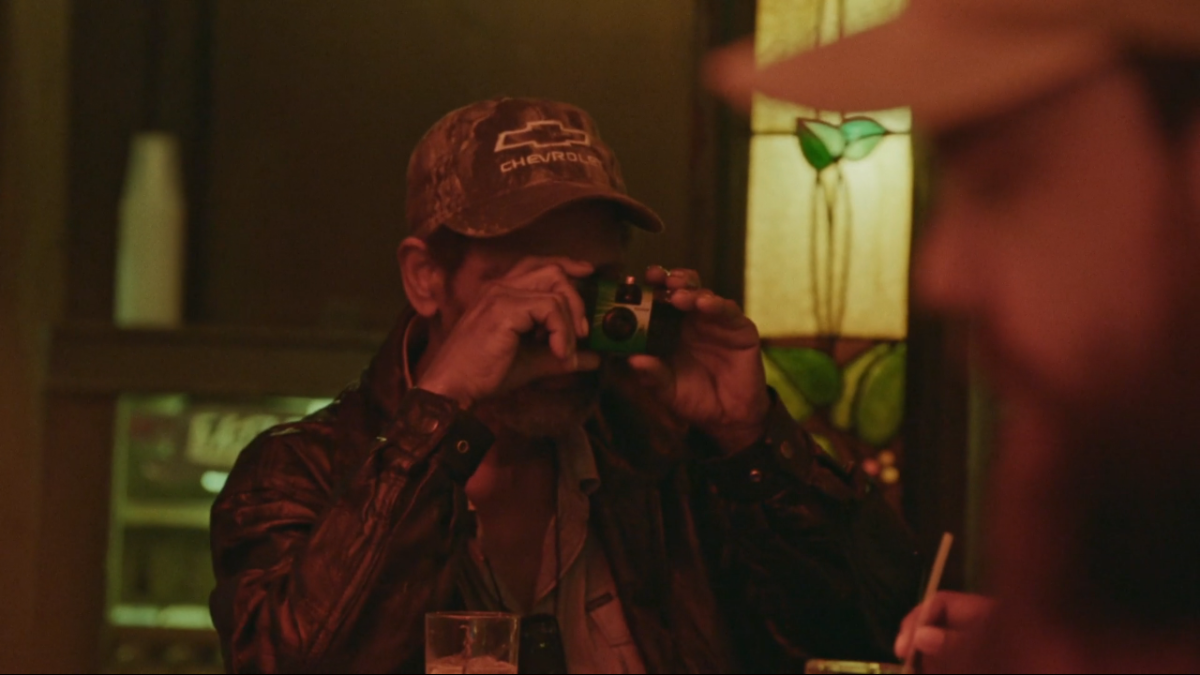
Coda
Apart from their own handheld cameras, there’s a second recording going on in each of the films. In Bloody Nose a small disposable camera is passed along a number of hands. These pictures appear alongside the end titles. Rogosin’s On The Bowery on the contrary opens with a set of still pictures of bums on the Bowery, setting a precedent frame. The Exiles too, opens with a somewhat strange set of photos by Edward Curtis, taken around the beginning of the 20th century, depicting an idyllic pre-modern past. Dusty and Sweets ends with production stills, with descriptions of the actors’ current whereabouts.
Real-life images are a classic element in documentaries or in fiction films that reenact true stories, as to prove how well a director reconstructed the original, merely patting themself on the back as a certificated conservator. Yet there’s a double pun when the Rosses turn to this trick, since first of all, the pictures were taken by the people in the bar/on the set, which means the after-images do not differ from what we saw in the film at all, there’s no contrasting both sets of reality, and secondly, there is no differentiation in time. The photos were made in the same timespan as the film, thus ridiculing any critical or contemplative distance—rather installing mementos for future nostalgia. The exact same goes for Mutrux’ production stills.
